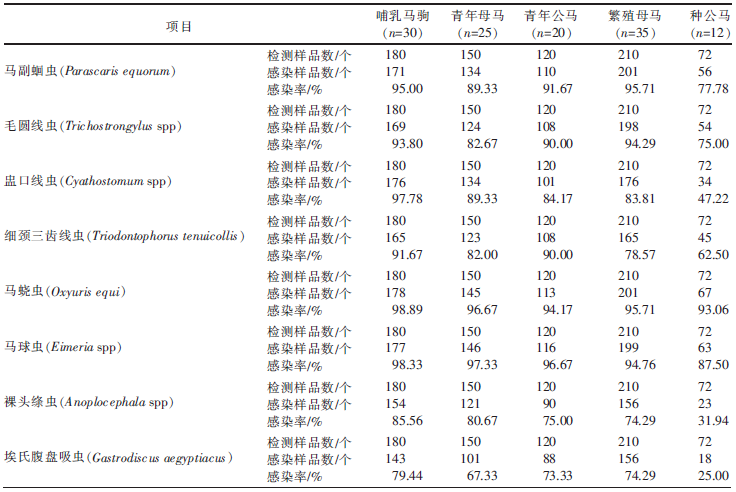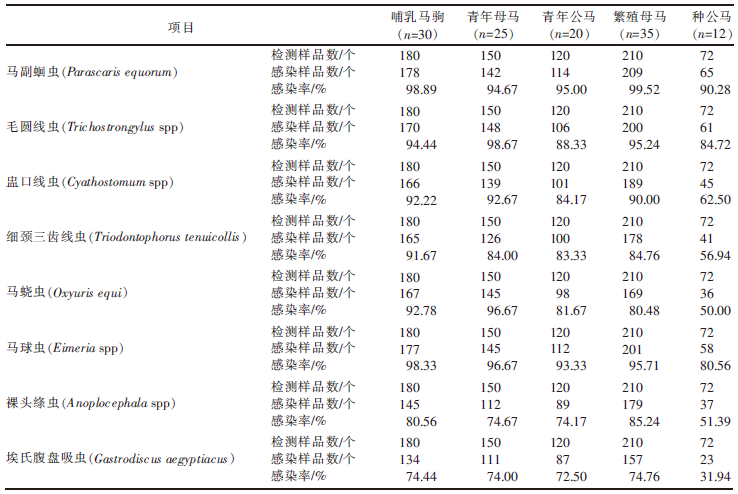| [1] |
张杨, 明·乌仁娜, 许正茂, 等. 伊犁河谷马寄生虫病流行现状[C]// 中国动物学会寄生虫学专业委员会第十五次全国学术会议暨第六次国际寄生虫学学术研讨会论文摘要集. [出版地不详]: [出版者不详], 2015:401.
|
| [2] |
刘桂兰, 刘爱玲, 王晓钧, 等. 马寄生虫感染情况与驱虫药物批准概况[J]. 中国动物保健, 2016, 18(1):41-43.
|
| [3] |
图尔荪·萨迪尔, 卡丽比努尔·尔肯, 朱玉涛, 等. 新疆阿勒泰富蕴县马自然感染消化道线虫情况初报[J]. 中国动物传染病学报, 2015, 23(3):69-72.
|
| [4] |
苏娃, 恩克博力德, 沙比提·阿不都热西提. 伊犁马消化道寄生虫感染情况调查[J]. 黑龙江畜牧兽医, 2015(18):117-118.
|
| [5] |
方超, 王玮, 李永畅, 等. 伊犁昭苏县舍饲马常见消化道寄生虫感染情况的动态观察[J]. 新疆畜牧业, 2013(7):20-21.
|
| [6] |
张建英, 田兴贵. 畜禽寄生虫病对毕节地区畜牧业的危害及防制对策[J]. 上海畜牧兽医通讯, 2011(1):50-51.
|
| [7] |
索勋, 杨晓野. 高级寄生虫学实验指导[M]. 北京: 中国农业科技出版社, 2005.
|
| [8] |
黄兵, 沈杰. 中国畜禽寄生虫形态分类图谱[M]. 北京: 中国农业科技出版社, 2006.
|
| [9] |
孔繁瑶. 家畜寄生虫学[M]. 2版. 北京: 中国农业大学出版社, 2010.
|
| [10] |
ALBAN L, HÄSLER B, VAN SCHAIK G, et al. Risk-based surveillance for meat-borne parasites[J]. Experimental Parasitology, 2020, 208:107808.
doi: 10.1016/j.exppara.2019.107808
|
| [11] |
刘新民, 陈海燕, 峥嵘, 等. 内蒙古典型草原马粪分解特征[J]. 生态学杂志, 2011, 30(11):2465-2471.
|
| [12] |
朱来华, 谭乐义, 王宫璞, 等. 2010年国际马病疫情动态[J]. 中国动物检疫, 2011, 28(2):75-81.
|
| [13] |
哈西巴特, 李永畅, 才仁加甫, 等. 新疆和静县焉耆马肠道线虫感染情况调查分析[J]. 草食家畜, 2015(3):43-46.
|
| [14] |
李永畅, 邓海峰, 索意利·李吉, 等. 伊犁河谷马匹感染消化道寄生虫分析[J]. 畜牧与兽医, 2015, 47(2):92-94.
|
| [15] |
陶银侠, 闫大任. 内蒙古高格斯台罕乌拉国家级自然保护区半散养东北马鹿粪便中寄生虫虫卵检测[J]. 畜牧与饲料科学, 2014, 35(10):12-13.
|
| [16] |
ROSANOWSKI S M, SCOTT I, SELLS P D, et al. Cross-sectional survey of parasite control practices on Thoroughbred and Standardbred training yards in New Zealand[J]. Equine Veterinary Journal, 2016, 48(3):387-393.
doi: 10.1111/evj.12558
pmid: 26708731
|
| [17] |
崔浩然, 杨浩宏, 席琳乔, 等. 新疆昭苏县定居牧户马匹饲养管理现状调查与分析[J]. 草食家畜, 2014(4):21-26.
|
| [18] |
李治国, 徐春艳, 侯旻昱, 等. 新疆部分地区牧马肠道寄生虫感染情况调查[J]. 畜牧与兽医, 2019, 51(9):87-90.
|
| [19] |
褚洪忠. 不同饲养管理条件对杂交伊犁马驹生长发育影响的研究[D]. 乌鲁木齐: 新疆农业大学, 2012.
|
| [20] |
明·乌尔娜. 新疆昭苏县马消化道常见寄生虫感染情况调查及驱虫效果评价[D]. 乌鲁木齐: 新疆农业大学, 2016.
|
| [21] |
张琳. 昭苏马场不同人工草地类型种植效益与优化模式研究[D]. 乌鲁木齐: 新疆农业大学, 2012.
|
| [22] |
邓海峰, 李晓斌, 马军, 等. 碘醚柳胺对6月龄伊犁马驹驱虫效果的研究[J]. 中国畜牧兽医, 2016, 43(11):3066-3072.
|
| [23] |
杜晓杰, 李永畅, 刘启生, 等. 新疆昭苏县引种纯血马消化道寄生虫感染情况调查[J]. 中国兽医杂志, 2015, 51(1):49-50.
|
| [24] |
王美玲. 新疆昭苏马消化道寄生虫动态调查及临床驱虫实验[D]. 乌鲁木齐: 新疆农业大学, 2015.
|
| [25] |
李跃增. 甘肃省马驽巴贝斯虫病流行情况与防治对策[J]. 中国兽医寄生虫病, 2006(1):47-50.
|
| [26] |
陈晖, 马玉辉, 马晨, 等. 新疆昭苏县不同季节和不同年龄段伊犁马消化道寄生虫感染情况的调查研究[J]. 畜牧与饲料科学, 2019, 40(9):1-5.
|
| [27] |
苏娃, 艾山江, 索意利·李吉, 等. 伊犁马疾病调查与病因浅析[J]. 畜牧与兽医, 2014, 46(11):135-136.
|
| [28] |
卡丽比努尔·尔肯, 吐尔地·艾买尔, 林涛, 等. 新疆喀什市周边地区驴体内滞留寄生虫的检查报告[J]. 草食家畜, 2014(3):58-61.
|
| [29] |
NIELSEN M K, PFISTER K, VON SAMSON-HIMMELSTJERNA G. Selective therapy in equine parasite control-Application and limitations[J]. Veterinary Parasitology, 2014, 202(3/4):95-103.
doi: 10.1016/j.vetpar.2014.03.020
|




